Whether you’ve just snagged a great deal on Italian sausages at the supermarket or you’re prepping for a big family barbecue months in advance, knowing how to properly freeze your meats is crucial for quality and safety. So, let’s get into the chilly details of freezing sausage!
Sausages come in all shapes, sizes, and flavors, but when it comes to freezing them, the rules are pretty consistent. Freezing not only helps keep your sausages safe to eat for a longer period but also retains their tastiness for that next grill-out or breakfast spread. But just how long is too long in the icy confines of your freezer?
The United States Department of Agriculture (USDA) gives us the low-down on freezing meats. For sausages, the USDA recommends that raw sausage made from chicken, turkey, pork, or beef should only be kept in the freezer for one to two months for the best quality. Cooked sausages, on the other hand, can last a bit longer, up to two to three months before quality starts to decrease.
Now, you might be wondering why there’s a recommended time limit if freezing food keeps it safe indefinitely. And you’re right, technically speaking; freezing food at 0°F (-18°C) stops bacterial growth in its tracks, meaning the sausage won’t become unsafe to eat after two months. However, the quality begins to decline due to factors like freezer burn, moisture loss, and texture changes. So, while your sausage might be safe to eat after an extended freeze, it might not give you that juicy, flavorful experience you’re looking for.
Let’s talk about how to freeze your sausage properly to maximize both safety and quality:
When it comes to safety, it’s important to remember that the way you handle sausage before and after freezing is just as important as how long you freeze it. Always wash your hands before and after handling raw meat, and ensure that you cook sausages to the appropriate internal temperature – that’s 160°F (71°C) for beef and pork sausages and 165°F (74°C) for chicken and turkey sausages, according to the FDA.


